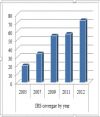Feasibility of Malaria Elimination in Ethiopia
- PMID: 33897221
- PMCID: PMC8054453
- DOI: 10.4314/ejhs.v30i4.16
Feasibility of Malaria Elimination in Ethiopia
Abstract
Background: The problem of malaria is very severe in Ethiopia where it has been the major cause of illness and death for many years. The purpose of this review article is to assess the feasibility of malaria elimination in Ethiopia.
Method: To compile this review article, different relevant research articles related to the topic from open access journals were searched using different searching engines such as Google scholar, Science direct, and Pub Med using different key words and phrases.
Result: Based on review of the literature, Ethiopia has been trying to control and eliminate malaria for more than 60 years. To assess feasibility of malaria elimination, the WHO assessment tools/recommendations for elimination of malaria were used. Based on WHO parameters, the country has achieved remarkable progress on the fight against malaria during the most recent decades. Malaria morbidity and mortality have been reduced dramatically with intensive use of insecticide residual spray, long lasting insecticide treated nets, chemotherapies, improved diagnosis and case management, improved quality of laboratories, continued support from malaria partners, and political commitment of the Ethiopian government towards malaria prevention and control. Hence, the past achievements and current activities, have led to consider the possibility of malaria elimination in Ethiopia at least by 2030 or beyond.
Conclusion: Considering the triumphs achieved so far and the current undertaking efforts, malaria could possibly be eliminated from Ethiopia once and for all.
Keywords: Elimination; Ethiopia; Malaria; feasibility; opportunity.
Copyright: © 2020 Gessessew Bugssa, et al.
Figures
Similar articles
-
Malaria epidemiology and stratification of incidence in the malaria elimination setting in Harari Region, Eastern Ethiopia.Infect Dis Poverty. 2020 Nov 22;9(1):160. doi: 10.1186/s40249-020-00773-5. Infect Dis Poverty. 2020. PMID: 33222698 Free PMC article.
-
Malaria indicator survey 2007, Ethiopia: coverage and use of major malaria prevention and control interventions.Malar J. 2010 Feb 24;9:58. doi: 10.1186/1475-2875-9-58. Malar J. 2010. PMID: 20178654 Free PMC article.
-
Factors influencing the ownership and utilization of long-lasting insecticidal nets for malaria prevention in Ethiopia.Malar J. 2017 Jul 1;16(1):262. doi: 10.1186/s12936-017-1907-8. Malar J. 2017. PMID: 28668084 Free PMC article.
-
Reshaping the vector control strategy for malaria elimination in Ethiopia in the context of current evidence and new tools: opportunities and challenges.Malar J. 2018 Dec 5;17(1):454. doi: 10.1186/s12936-018-2607-8. Malar J. 2018. PMID: 30518395 Free PMC article. Review.
-
Malaria epidemiology and interventions in Ethiopia from 2001 to 2016.Infect Dis Poverty. 2018 Nov 5;7(1):103. doi: 10.1186/s40249-018-0487-3. Infect Dis Poverty. 2018. PMID: 30392470 Free PMC article. Review.
Cited by
-
Burden and seasonal distribution of malaria in Ziquala district, Northeast Ethiopia: a 5-year multi-centre retrospective study.BMJ Open. 2023 Aug 18;13(8):e067103. doi: 10.1136/bmjopen-2022-067103. BMJ Open. 2023. PMID: 37597861 Free PMC article.
-
Prevalence and associated risk factors of malaria among febrile under-five children visiting health facilities in Ziquala district, Northeast Ethiopia: A multicenter cross-sectional study.PLoS One. 2022 Oct 27;17(10):e0276899. doi: 10.1371/journal.pone.0276899. eCollection 2022. PLoS One. 2022. PMID: 36301956 Free PMC article.
-
Prevalence of asymptomatic malaria and associated factors among pregnant women in Ethiopia: systematic review and meta-analysis.Front Reprod Health. 2023 Oct 11;5:1258952. doi: 10.3389/frph.2023.1258952. eCollection 2023. Front Reprod Health. 2023. PMID: 37886226 Free PMC article. Review.
-
Seasonal Profile and Five-Year Trend Analysis of Malaria Prevalence in Maygaba Health Center, Welkait District, Northwest Ethiopia.J Parasitol Res. 2021 Sep 10;2021:6727843. doi: 10.1155/2021/6727843. eCollection 2021. J Parasitol Res. 2021. PMID: 34545309 Free PMC article.
-
Communicable and Non-communicable Diseases Diagnosis and Treatment Service Availability at Primary Health Care Units During COVID-19 Outbreak in Ethiopia.Ethiop J Health Sci. 2023 Oct;33(Spec Iss 2):95-104. doi: 10.4314/ejhs.v33i2.3S. Ethiop J Health Sci. 2023. PMID: 38352666 Free PMC article.
References
-
- White Nicholas, Sasithon P, Hien Tran, et al. Malaria, seminar. Lancet. 2014;383:723–35. - PubMed
-
- WHO Malaria vaccine: WHO position paper. Weekly epidemiological record. 2016a;91(4):33–52. - PubMed
-
- Senay Gabriel, Verdin James. Developing a Malaria Earky Warning System for Ethiopia. National Center for EROS. Twenty Fifths Annual ESRI International User Conference. 2005. Paper No.UC2409. San Diego.
Publication types
MeSH terms
LinkOut - more resources
Full Text Sources
Medical
Miscellaneous


